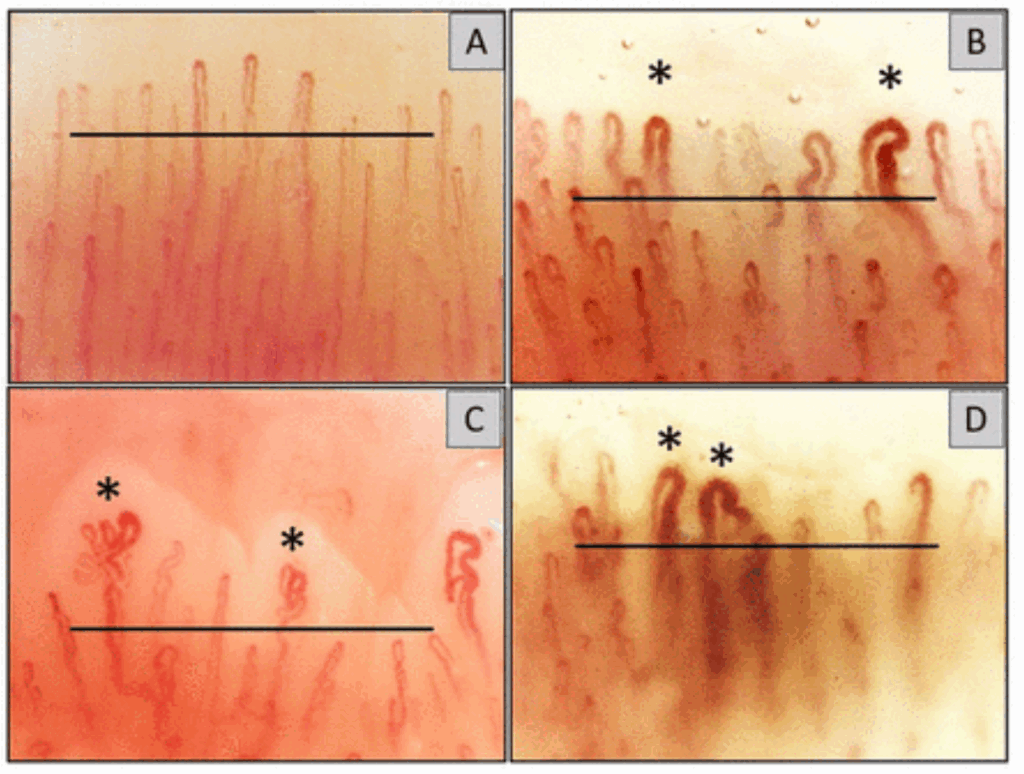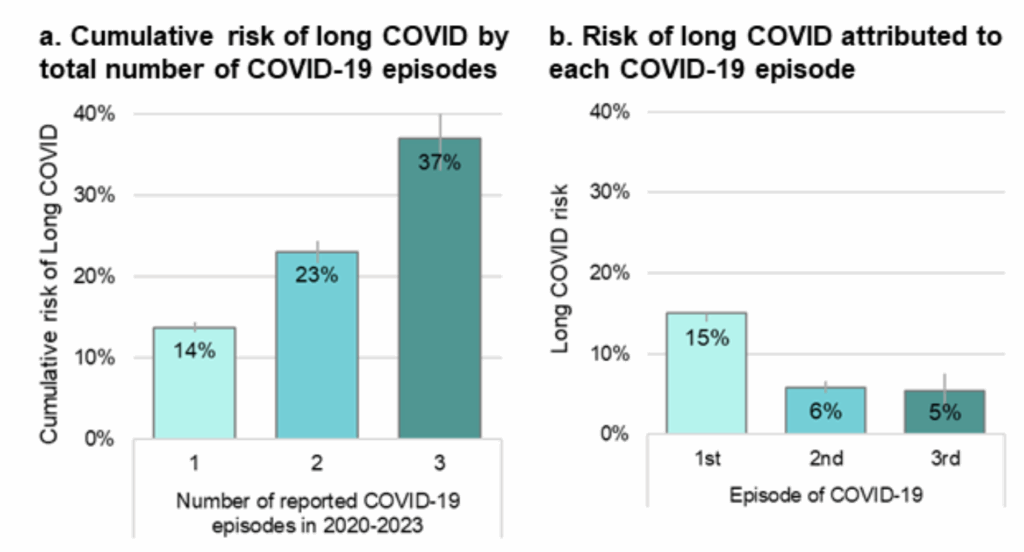COVID-19
COVID cases are still low in BC, but rising slightly. As a heads up, Taiwan (2025-05-13), Singapore (2025-05-13), Hong Kong (2025-05-15) Vietnam (2025-05-14), Thailand (2025-05-10) and Iran (2025-05-12) are noting an increase in cases.
Long COVID
🎉🎉🎉 This paper from Italy (2025-04-27) reports that people with Long COVID have more abnormalities (microhemorrhages, dilations, and funky shapes) visible in capillaries under the fingernail than people who had COVID-19 infections but not Long COVID (RC), matched healthy controls (HC), or pre-COVID measurements from the same patients. (NB: RC patients did have more dilations than HC.)
They also found that Long COVID patients had a lower density of capillaries than RC or HC.
They saw this with a test called a nailfold capillaroscopy, where they look at the capillaries at the bottom of the fingernail (still attached to the hand!) with an optical microscope:

B: Had COVID-19 but not Long COVID (RC)
C: Long COVID
D: Long COVID
Note that there are a lot more capillaries in A and B than C &D, and that they are thinner.in A than in any of the people who had COVID-19 infections.
🎉🎉🎉 This seems like it would be a really fast/cheap/painless/useful Long COVID test!
🩸 This paper from UK (2025-05-09) reports that the mitochondiral function in CD14++ monocytes — a form of white blood cell — are seriously messed up in Long COVID patients. The monocytes especially don’t cope well with oxidative stress.
💉This paper from USA (2025-05-09) looked at vaccination in 16 patients with Long COVID. Based on a survey, at 12 weeks post-vaccination:
- 10 participants got better;
- 3 had no change;
- 2 got better for a bit but then got worse;
- 1 got worse.
This paper from Quebec (2025-05-09) surveyed healthcare workers about Long COVID and found:
- People with Omicron infections had a lower risk of Long COVID than people with pre-Omicron infections, and a lower risk of a severe infection. (NB: this might have been due to people having more immunity due to vaccination and infection.)
- People who had severe acute COVID-19 infections had a higher risk of developing Long COVID, and a higher risk of more severe Long COVID.
- Among those who had Long COVID, 24% were mild cases, 43% were moderate cases and 33% were severe cases.
The abstract says that the risk of developing Long COVID as the result of a first infection was three times higher than for a reinfection. However, their math on that assertion doesn’t compute.
While the results section says that the incremental risk is 14.8% for a single infection, 5.8% for the second infection, and 5.3% for the third infection. Note that these are probabilities of getting LC on the Nth time given not getting it on all the previous times, which means you need to do a simple sum. The cumulative probability of having LC after your second infection is thus P(first)+P(second)=20.6%, which is less than 23%. The cumulative probability of having LC after your third infection is 20.6%+P(third) = 20.6%+5.3% = 25.9%, which is way less than 37%.

This paper from BC (2025-05-05) reports that, of the people who had a verified COVID-19 infection at least two years earlier, 18.7% had self-reported Long COVID. Compared to people who had had COVID-19 infections but not Long COVID, the long haulers on average lost, on average, about 30 hours per month of productivity.
This preprint from Spain (2025-05-07) reports that Vascular endothelial growth factor A (VEGF-A) is overexpressed in female Long COVID patients and underexpressed in male Long COVID patients. VEGF-A does many things, but it’s heavily involved in things related to blood vessels and hormonal regulation. However, the Wikipedia page says that when “cells are deprived of oxygen, they increase their production of VEGF-A”, so elevated VEGFA might be a symptom and not a cause, at least in women?
💉🎉 This article from USA (2025-05-17) reports that the FDA has (finally!) given full approval (as opposed to Emergency Use Authorization) to Novavax’s COVID-19 vaccine — with some catches. The only approved it for people over 65 and those who had a medical condition which put them at greater risk for severe COVID. They also are requiring that Novavax do three more studies investigating myocarditis and pericarditis after vaccination.
This paper from USA (2025-05-13) reports that people who had lower fitness before getting COVID had a higher risk of getting Long COVID.
This paper from Japan (2025-05-12) looks at Long COVID in kids and their parents and found that 34.4% of the parents had ME/CFS symptoms at six months, but only 5.9% of the kids. If we can extrapolate, that means that 1/6th as many kids get Long COVID as adults — clearly far fewer than adults, but also clearly not zero.
Mitigation Measures
💡 I have been paying a bit of attention to Far-UV lights as a disinfecting / air purifying technique. This paper from Japan (2024-12-10) reports that in three years of very careful monitoring, no ill effects of any kind were found in people (ophthalmologists, actually) who worked in the rooms where the Far-UV lights shone at 22 mJ/cm2.
There are some concerns still about the ozone that Far-UV lights produce. See, for example, this article (2024-11-13). But the paper from Japan adds more evidence that Far-UV isn’t a danger to eyes.
Pathology
This paper from USA (2025-05-09) reports that COVID-19 infections raise the risk of miscarriages by around 2.5 times the risk of women who did not have COVID-19 infections.
🩸This paper from Europe (2025-05-12) reports that blood from people recovering from mild COVID showed that their red blood cells were significantly less deformable and clumped more (especially in women) compared to healthy controls. These changes correlated with fibrinogen and D-dimer levels, which is a sign of systemic inflammation and hypercoagulability.
Treatments
💊This paper from Germany (2025-05-12) reports that Vitamin B3 reduces both the time to recover from the acute phase of COVID-19 and the severity of Long COVID symptoms. The benefits are not astonishingly large, but on the other hand, B3 is poses little risk.
One interesting subgroup was people who were getting better. Among people who were getting better, the people who got B3 got better faster/more.
This study from Spain (2025-05-12) found that COVID-19 patients given remdesivir were 27% less likely to die in-hospital within 28 days. (That’s good, because remdesivir is now standard-of-care for hospitalized patients!)
This review paper (2025-05-13) reports that adults hospitalized with COVID-19 were 33% less likely to die if they got JAK inhibitors (baricitinib, tofacitinib, and ruxolitinib) than if they didn’t.
Testing
💩 This paper from USA (2025-05-08) verified that wastewater concentrations of COVID-19 correlated well with absences in healthcare workers (used as a proxy for COVID-19 cases late in the pandemic).
The researchers noted that three of the sharp rises were in the summer, when people spend more time outdoors and kids are not in school. (We see this in BC, too.)
BC
Health Care System
BC has been deliberately recruiting healthcare workers from USA.
🎉🧑⚕️‼️ This article (2025-05-12) says that in the month since the licensing transfer rules have been relaxed, 1,200 healthcare workers have expressed interest, and 177 nurses have already formally applied to have their licenses transferred. (They do still need to get a job offer and get a work visa.)
Churches
✝️ St. Margaret’s Anglican Church in Vancouver, near Kingsway and Knight, still requires masks, and has a lovely web page on why!
Transparency
🤐 This article (2025-05-14) reports that the Canadian Association of Journalists has awarded Vancouver Coastal Health the 2024 “Code of Silence Award for Outstanding Achievement in Government Secrecy” for routinely flouting access to information laws during the pandemic state of emergency.
Mitigation Measures
St. Margaret’s (see immediately above) is selling air filters as a fundraising thing, and they actually look pretty good: like a Corsi-Rosenthal box, but with computer fans. Order by May 20th!
Wastewater
Wastewater COVID-19 levels are still going up in Fraser Health, but oddly, they seem to be staying pretty much the same in other health authorities. From Jeff’s wastewater spreadsheet:

MERS
Transmission
🐪 Oh great. This press release from the World Health Organization (2025-05-12) says that nine new cases of MERS have popped up, and two people died. Only one of those cases had contact with camels or camel products; six of the cases were healthcare workers who had cared for the same infected patient.
